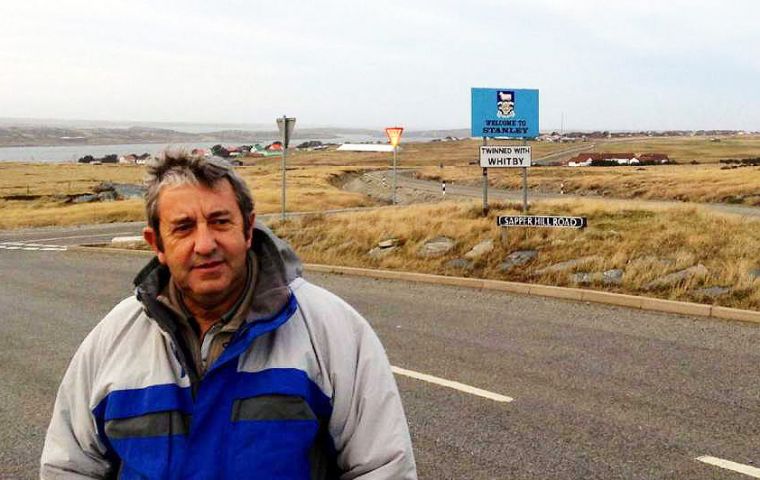MercoPress. South Atlantic News Agency
Argentina surfaces three Spanish Malvinas documents from 1767
 Senator Cobos is no stranger to the Falklands, he visited them in June/July 2014, before launching a presidential bid
Senator Cobos is no stranger to the Falklands, he visited them in June/July 2014, before launching a presidential bid Argentine former vice president and currently Senator of the ruling coalition, Julio Cobos has announced the discovery of three letters dated 1767, revealing an exchange of information between then Buenos Aires city governor, and Felipe Ruiz Puente, described as the first Malvinas Islands governor. At the time was part of the Spanish colonial empire.
The documents, apparently authentic are considered a strong contribution to the Argentine claim over the Falkland Islands.
Senator Cobos did not reveal the origin of the three letters, except for the mention of an undisclosed collector of historic documents, but did say in a release from his office that he reported the discovery to the government and following several meetings it was decided to have the documents sent to the Industrial Technology Institute to prove that they were authentic, something which was later confirmed as positive.
The three letters are now in custody of Argentina's National Archive.
“It is with great pleasure that we must mention the recovery of this heritage evidence, a further step in again confirming the solid reasons brandished by Argentina's unrenounceable sovereignty claim over the Malvinas Islands”, Cobos was quoted in the Argentine media.
In the release Cobos, who is no stranger to the Falklands, he visited them in June/July 2014, before launching a presidential bid, added that “The Islands have been, are and will be Argentine, and today with these three documents we are three steps closer ”
The letters written in old Spanish are what can be considered a normal exchange between two administrations, in Buenos Aires Francisco Bucarelli y Ursúa and in the Falklands, Ruiz Puente.
The first dated 18 February 1767 reports the dispatch of eight prisoners, with no pay, as labor for the Malvinas Governorship created four months before following on orders from then Spanish King Carlos III.
A second letter from the Falklands, dated 25 April 1767 sent by Ruiz Puente to governor Bucarelli y Ursúa, suggesting the need to mount a chapel in Malvinas, for “all the people”. Apparently the only facility was very precarious with an image of Saint Louis, and thus formally requests “a small shrine with a sacred cup, and an advocate image that Your Excellency determines as patron of this possession”.
The third document from Buenos Aires, dated 2 December 1767, governor Bucarelli y Ursúa notifies the dispatch of “sacred vases and ornaments for the new chapel in Malvinas”, as well as an image of the Virgin of Solitude to be declared the patron virgin of the local population.
Senator Cobos underlines that this is probably the only “official” document in which the name Isla Soledad (as Argentines identify East Falkland) emerges, and the only also to mention the existence of a Patron Virgin of the Malvinas Islands.




Top Comments
Disclaimer & comment rules-

-

-

Read all commentsHmmm. So what have we got?
Nov 07th, 2017 - 09:39 am +81. On February 18, 1767 Governor Bucarelli writes to the soon to take-over from the French, Governor Puente - who is in MONTEVIDEO - to offer some prisoners as labourers at Fort Louis. Please note that Puente did not sail from Montevideo until February 28 and did not arrive at Fort St, Louis until March 24; a day after Bougainville got there (and who recorded it all).
2. On April 25, Governor Puente, thinking that the French arrangements are poor (I'm being polite), writes to Governor Bucarelli asking for a chapel, a religious icon and some ornaments etc. Presumably because there were no shops open and he was feeling isolated (you should see the letter he wrote on the 27th)
3. In December, Gov. Bucarelli writes to Gov. Puente to say he'll send a chapel, an icon and some religious ornaments etc., as requested.
During the same 11 months, the British completed around Port Egmont (which is not on Saunders Island by the by), a fort (Fort George) a settlement (Jasons Town), an observation platform and a fishing pavilion.
While the Spaniards huddled around their fires. Did you know that the Acadians laughed at them? Well, after Canada, the Falklands were downright balmy.
All of which means, that these letters, mildly interesting as they are (and yes Think, they'll feature in the next update) are in fact completely inconsequential with regards to the sovereignty of the Falklands.
Cobos does not appear to know his arse from his elbow; or should I say his artifact from his evidence?
Have I ever mentioned, in passing perhaps, that Argentina is not Spain? Yes?
Great! We look forward to the Republic of Argentina presenting these, plus any other supporting documentation in their possession, before the fifteen Judges at the United Nations International Court of Justice in Den Haag, Netherlands.
Nov 07th, 2017 - 09:43 am +8I am not holding my breath though ;-D
Except that Spanish claims to the Falklands are irrelevant and have no bearing on Argentine claims. By Argentine logic, Argentina should rule Jamaica since (a) Jamaica was once a Spanish possession in the New World, and (b) the current Jamaicans are an 'implanted' population put there by 'England' and so the Jamaicans should have no say in the sovereignty or government of Jamaica.
Nov 10th, 2017 - 04:35 am +7Commenting for this story is now closed.
If you have a Facebook account, become a fan and comment on our Facebook Page!